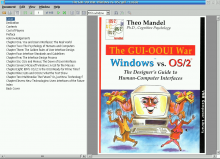The GUI-OOUI War - Theo Mandel
This book discusses interfaces in general and focuses on today's graphical user interfaces (GUIs) and object-oriented user interfaces (OOUIs). Discussions are supplemented with examples and pictures of interfaces and objects that demonstrate the different operating system and user interface styles and elements.
The book details the key user interface design principles, guidelines, and a basic user interface design process you can follow.
The psychology of computers and the history of user interfaces will be addressed, from the command line interface of DOS to the GUI and OOUI interfaces you see today. The book also covers the direction of future computer technologies, such as multimedia, mobile computing, and pen-based systems.
Over the years, users have gradually migrated from command-line interfaces to graphical user interfaces and onward to object-oriented user interfaces.
During this transaction there has been frustration working on computers (and only occasionally joy).
The author therefore psychologicaly inquiries this intricate and interesting relationship between humans and computers that should help you focus on the user's perspective and how software must be designed to meet the user's needs, not the designer's or programmer's needs.


This work is licensed under a Creative Commons Attribution 4.0 International License.
Add new comment